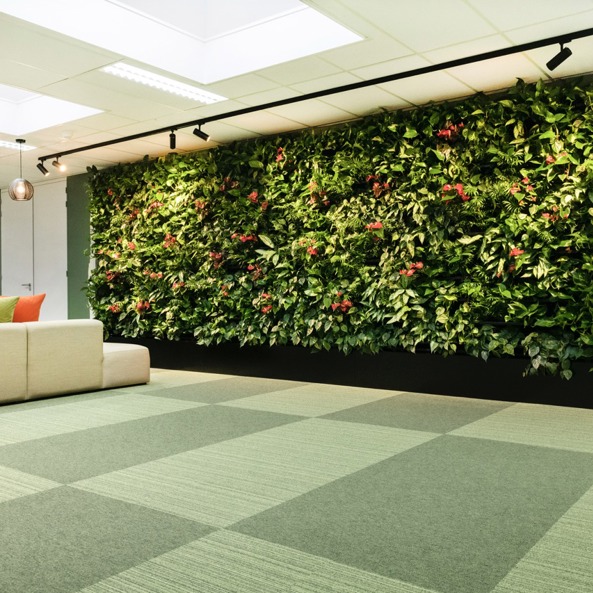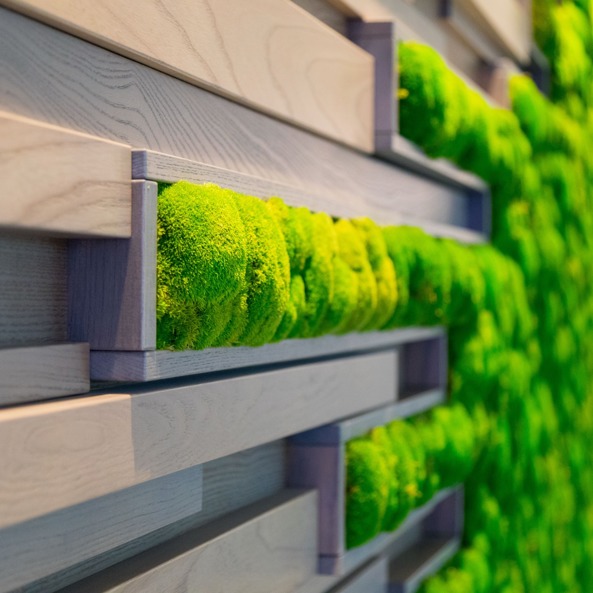"Will a living wall actually save money on my energy bills?"
"Are plant walls worth the investment beyond their aesthetic appeal?"
These questions have become increasingly common as building owners and managers search for sustainable solutions to rising energy costs. Living walls—whether indoor plant systems, outdoor vertical gardens, or moss installations—are often praised for their visual appeal, but their practical benefits deserve closer examination.
Recent research, including a comprehensive 2023 study published in Building and Environment, demonstrates that living walls can reduce building energy consumption by 5-30% depending on climate, orientation, and system design. With energy prices continuing to rise through 2025, these living systems offer more than just biophilic design elements—they provide measurable returns on investment through passive cooling and insulation effects.
How Living Walls Cool Buildings
Living walls cool buildings through several interconnected mechanisms. Evapotranspiration—the combined process of water evaporation from soil and plant transpiration—creates a significant cooling effect. When plants release water vapor, they absorb energy from their surroundings, lowering ambient temperature. The 2023 Building and Environment study found this process alone can reduce surface temperatures by 4-6°C on exterior walls.
Plant foliage also provides direct shading, preventing solar radiation from reaching and heating building surfaces. For outdoor installations, this creates an insulating air layer between the plants and building facade. Additionally, the substrate or growing medium adds another layer of insulation, reducing heat transfer through the building envelope.
For indoor living walls, the cooling effect extends beyond surface temperatures to improve overall thermal comfort. Plants naturally humidify and filter air, creating microclimates that often allow for higher thermostat set points without reducing comfort—a direct path to energy savings.

Quantifiable Energy Savings
The energy-saving potential of living walls has moved beyond theoretical benefits to measurable outcomes. According to research published in the Journal of Building Engineering, temperature reductions of 2-8°C for interior spaces adjacent to exterior living walls during summer months can translate to energy savings between 15-25% for cooling in temperate climates.
For context, a mid-sized office building in the UK implementing an outdoor living wall system could save approximately £2,500-£7,000 annually on cooling costs based on current energy prices. The savings variations depend largely on the building's orientation, with west and south-facing facades showing the greatest benefit in northern hemisphere locations.
Indoor living walls show more modest but still significant effects on HVAC energy consumption. Research indicates they can reduce the need for mechanical cooling by 5-10% in commercial spaces through their contribution to more stable humidity levels and temperatures. This effect is amplified when living walls are strategically placed near air return vents where they can influence the air being recirculated.
While initial installation of comprehensive living wall systems ranges from £500-£1,200 per square meter (as of 2025 according to industry reports), the energy savings typically produce payback periods of 7-12 years, shorter than many other building envelope improvements.
Indoor Living Walls: Temperature Regulation Benefits
Indoor living walls create microclimate effects that improve the efficiency of existing HVAC systems. The most significant energy benefit comes from humidity regulation. Plants naturally release moisture into the air through transpiration, helping maintain optimal humidity levels of 40-60%. This natural humidification allows for slightly higher air conditioning temperatures without loss of comfort. For every 1°C increase in thermostat settings, buildings typically save 3-5% on cooling energy according to the Carbon Trust.
Plants with high transpiration rates and large leaf surface areas typically provide the greatest cooling benefits, including:
● Devil's ivy (Epipremnum aureum)
● Peace lily (Spathiphyllum)
● Boston fern (Nephrolepis exaltata)
● English ivy (Hedera helix)
● Spider plant (Chlorophytum comosum)
Many businesses incorporating office plants in strategic locations have documented both energy savings and improved employee comfort levels.
Outdoor Living Walls: Building Envelope Performance
Outdoor living walls function as dynamic building envelope components, intercepting solar radiation before it reaches structural materials. The Building and Environment study found that exterior wall surface temperatures behind living walls were reduced by up to 20°C during peak summer conditions compared to bare facades.
The performance varies considerably by climate zone. In the UK and similar temperate regions, the cooling effect is most valuable from June through September. Even in cooler months, evergreen living wall systems provide insulation value by trapping an air layer between the plants and the building surface.
For businesses with outdoor spaces like pub gardens, living walls can help create comfortable microclimates for customers while simultaneously benefiting building energy performance.
Moss Walls: A Special Case
Moss walls differ significantly from traditional living walls but offer unique benefits for certain applications. Their primary thermal advantage comes from exceptional insulation properties. Moss naturally creates dense, air-trapping layers that reduce thermal conductivity through wall surfaces.
Humidity regulation is where moss walls truly excel. Moss can absorb up to 20 times its weight in moisture from the air, releasing it gradually as conditions change. This natural buffering helps maintain consistent indoor humidity levels, reducing the energy needed for humidification or dehumidification.
Maintenance energy must be considered in any living wall calculation. Here, moss walls offer a distinct advantage. Unlike leafy plant walls, preserved moss walls require no irrigation, fertilization, or light energy inputs, making their ongoing energy footprint minimal.

Implementation for Maximum Benefits
Achieving optimal energy benefits from living walls requires thoughtful planning. For outdoor applications, priority should be given to south and west-facing facades in the UK, where solar heat gain is greatest. For indoor installations, placing living walls near return air vents maximizes their influence on recirculated air.
Size and coverage matter significantly. For meaningful energy impact, living walls should cover at least 15-20% of the target facade or interior zone. Integration with building management systems represents the frontier of living wall technology, with smart irrigation systems that respond to environmental conditions not only keeping plants healthy but optimizing water use.
For buildings seeking to maximize return on investment, a phased implementation approach often works best. Starting with high-impact areas allows for performance measurement and system optimization before expanding coverage. Professional grounds maintenance services can ensure living walls continue to perform optimally year-round.
Conclusion
Living walls—whether indoor plant systems, outdoor vertical gardens, or moss installations—offer substantial and measurable energy benefits beyond their aesthetic appeal. With energy savings ranging from 5-30% depending on application and design, they represent a viable technology for building owners seeking sustainable approaches to rising energy costs.
The most successful implementations treat living walls as integral building systems rather than decorative afterthoughts. By considering their placement, scale, plant selection, and integration with other building systems, owners can maximize both energy savings and the numerous co-benefits these remarkable green technologies provide.


























